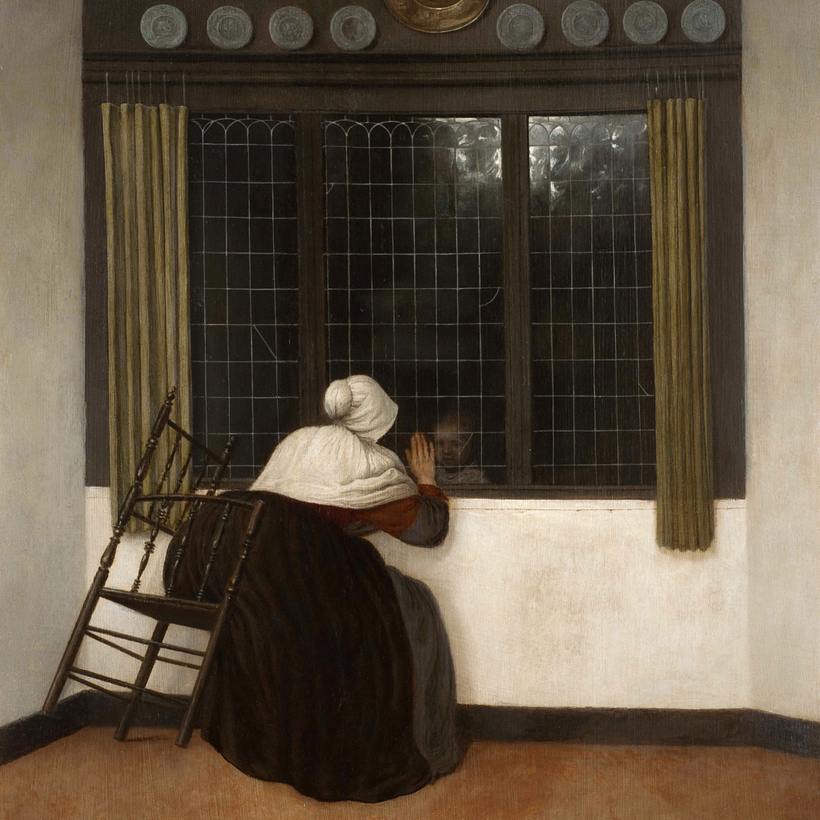Who was Jacobus Vrel? No one really knows, except that he was a remarkable 17th-century Dutch artist of about 50 interiors and street scenes of everyday life, several of which were until recently attributed to Johannes Vermeer and Pieter de Hooch.
“It would be very interesting to discover one day something about Vrel’s life,” says Quentin Buvelot, curator of the exhibition “Vrel: Enigmatic Forerunner of Vermeer,” which opens today at the Fondation Custodia, in Paris, and will be presented there until September 17. The show has 22 paintings and one drawing by Vrel and several works by his contemporaries. (A smaller version of the exhibition was on at the Mauritshuis, in The Hague, this past spring.)
“So little is known about Vrel,” says Buvelot, who is senior curator of the Mauritshuis. “It remains unknown where he lived and worked, and even his dates have yet to be discovered. Was painting his livelihood? This has been doubted, owing to his small oeuvre. Did he have another source of income? For 150 years, scholars have been trying unsuccessfully to solve the mystery of this fascinating phenomenon.”

Nevertheless, scholars and the art market are increasingly focusing their attention on Vrel.
A recent research project created by the three museums that organized the exhibition—the Fondation Custodia, the Mauritshuis, and the Bavarian State Painting Collection, in Munich—provided clues to the probable dates of Vrel’s paintings: studies into the rings of his wooden panels proved that the paintings were older than originally thought.
Reactions to his works have ranged widely: “curious,” “with figures introverted,” “strangely stage-like,” “hauntingly empty,” “spooky,” and “affecting.”
“There is clearly renewed interest in his work,” said David Pollack, a senior vice president of Sotheby’s and an expert in old masters.
Vrel paintings are in private collections and museums in the U.S., Germany, Austria, Belgium, France, England, and Russia. The auction record for a Vrel is $2.3 million, for a painting sold in Paris in 2013. (The estimate for that painting was listed as $104,000 to $156,000.)
The only contemporary buyer of Vrel was said to be Austria’s archduke Leopold Wilhelm, whose curator was the artist David Teniers the Younger. Vrel was “re-discovered,” according to scholars, in the last half of the 19th century, by the French critic Théophile Thoré-Bürger, who is also credited with re-discovering Vermeer.

Buvelot is co-editor of the engrossing monograph and catalogue raisonné of Vrel’s paintings published by Hirmer for the exhibition. His co-editors were Cécile Tainturier, curator of the Fondation Custodia, and Bernd Ebert, head of Dutch and German Baroque painting at the Bavarian State Painting Collection.
In it, they write: “Despite comprehensive searches in numerous archives in the Netherlands, no clear trace of [Vrel] has been found. None of the municipal registers, no baptismal, marriage or death register, no indices of notarial records and especially none of the guild registers of well-known art centers list his name. The surname Vrel or variations on it do occasionally appear.... Unusually, moreover, none of his works is mentioned in contemporary documents in the Netherlands.
“To this day, the fruitless search for the ‘phantom’ of Vrel continues to give rise to various hypotheses as to when and where exactly the artist was active.”
Vrel’s creative period is generally narrowed down to between 1654 and 1662, based on his only signed and dated painting, Woman Leaning Out of an Open Window (1654), now owned by the Kunsthistorisches Museum, in Vienna.
The spelling and the handwriting on Vrel’s paintings, Buvelot tells me, show all kinds of variations: “J. Vrel,” “Jacobus Vrelle,” or “Jaco/bus,frell.” Most of the works are signed with his initials, or with a monogram with the initials “J” and “V.”

“Vrel has fascinated me for more than 20 years,” Buvelot says. “He created his own world, and I like the quirkiness of his paintings. The imperfect rendering of the perspective gives the scenes a rather naïve charm.
“My favorite painting by Vrel is A Seated Woman Looking at a Child Through a Window, at the Fondation Custodia. It shows the enigmatic universe of Vrel: an interior with empty white walls, and a scrap of paper on the floor bearing Vrel’s signature. The lack of detail and the ‘emptiness’ of the scene is quite atypical for 17th-century Dutch painting.
“Vrel’s paintings are an invitation to take the time to look, inviting you to pay more attention to the details, such as the broken panes in the windows or a nail and its shadow on a white plastered wall.”
Buvelot summed up Vrel this way: “Perhaps it’s the mystery surrounding the artist that determines the appeal of his paintings. Jacobus Vrel remains elusive, but his scenes deserve to be discovered.”
“Vrel: Enigmatic Forerunner of Vermeer” is on at the Fondation Custodia, in Paris, through September 12
Milton Esterow was the editor and publisher of ARTnews from 1972 to 2014. He currently contributes to The New York Times, The Atlantic, and Vanity Fair

